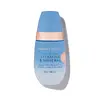What's inside
What's inside
 Key Ingredients
Key Ingredients

 Benefits
Benefits

 Concerns
Concerns

 Ingredients Side-by-side
Ingredients Side-by-side

Zinc Oxide 12%
Cosmetic ColorantWater
Skin ConditioningC12-15 Alkyl Benzoate
AntimicrobialCaprylic/Capric Triglyceride
MaskingJojoba Esters
EmollientTridecyl Salicylate
Skin ConditioningPropanediol
SolventPolyglyceryl-4 Diisostearate/Polyhydroxystearate/Sebacate
EmulsifyingNiacinamide
SmoothingMethylpropanediol
SolventSilica
AbrasiveNylon-12
Coco-Caprylate
EmollientTulipa Gesneriana/Kaurmanniana Meristem Cell Lysate Filtrate Extract
Helianthus Annuus Extract
EmollientGlycerin
HumectantSodium Hyaluronate
HumectantSodium Lactate
BufferingBisabolol
MaskingAllantoin
Skin ConditioningOryza Sativa Bran Extract
Skin ConditioningTocopherol
AntioxidantLentinus Edodes Extract
Skin ConditioningTerminalia Ferdinandiana Fruit Extract
AntioxidantPodocarpus Elatus Fruit Extract
Skin ConditioningPleiogynium Timoriense Fruit Extract
Skin ConditioningLecithin
EmollientHydrogenated Lecithin
EmulsifyingLeuconostoc/Radish Root Ferment Filtrate
AntimicrobialRosmarinus Officinalis Leaf Extract
AntimicrobialSodium Chloride
MaskingPolyglyceryl-2 Dipolyhydroxystearate
Skin ConditioningCaprylyl Glycol
EmollientMethylheptyl Isostearate
Skin ConditioningPhenylpropanol
MaskingTetrasodium Glutamate Diacetate
Sodium Gluconate
Skin ConditioningPentylene Glycol
Skin ConditioningSodium Hydroxide
BufferingPhenethyl Alcohol
MaskingPotassium Sorbate
PreservativeAlcohol
AntimicrobialHamamelis Virginiana Water
AstringentCitric Acid
BufferingCI 77499
Cosmetic ColorantCI 77492
Cosmetic ColorantCI 77491
Cosmetic ColorantZinc Oxide 12%, Water, C12-15 Alkyl Benzoate, Caprylic/Capric Triglyceride, Jojoba Esters, Tridecyl Salicylate, Propanediol, Polyglyceryl-4 Diisostearate/Polyhydroxystearate/Sebacate, Niacinamide, Methylpropanediol, Silica, Nylon-12, Coco-Caprylate, Tulipa Gesneriana/Kaurmanniana Meristem Cell Lysate Filtrate Extract, Helianthus Annuus Extract, Glycerin, Sodium Hyaluronate, Sodium Lactate, Bisabolol, Allantoin, Oryza Sativa Bran Extract, Tocopherol, Lentinus Edodes Extract, Terminalia Ferdinandiana Fruit Extract, Podocarpus Elatus Fruit Extract, Pleiogynium Timoriense Fruit Extract, Lecithin, Hydrogenated Lecithin, Leuconostoc/Radish Root Ferment Filtrate, Rosmarinus Officinalis Leaf Extract, Sodium Chloride, Polyglyceryl-2 Dipolyhydroxystearate, Caprylyl Glycol, Methylheptyl Isostearate, Phenylpropanol, Tetrasodium Glutamate Diacetate, Sodium Gluconate, Pentylene Glycol, Sodium Hydroxide, Phenethyl Alcohol, Potassium Sorbate, Alcohol, Hamamelis Virginiana Water, Citric Acid, CI 77499, CI 77492, CI 77491
Water
Skin ConditioningIsohexadecane
EmollientDimethicone
EmollientIsopropyl Isostearate
EmollientIsopropyl Myristate
EmollientC18-36 Acid Triglyceride
EmollientGlycerin
HumectantPropanediol
SolventCucurbita Pepo Seed Extract
Skin ConditioningMagnesium Sulfate
PEG-30 Dipolyhydroxystearate
EmulsifyingDimethicone Crosspolymer
Emulsion StabilisingAdansonia Digitata Fruit Extract
EmollientEthylhexylglycerin
Skin ConditioningHibiscus Sabdariffa Flower Extract
Skin ConditioningHydrogenated Lecithin
EmulsifyingMaltodextrin
AbsorbentPhyllanthus Emblica Fruit Extract
HumectantTocopherol
AntioxidantSodium Chloride
MaskingPhenoxyethanol
PreservativeSodium Benzoate
MaskingIron Oxides
CI 77891
Cosmetic ColorantWater, Isohexadecane, Dimethicone, Isopropyl Isostearate, Isopropyl Myristate, C18-36 Acid Triglyceride, Glycerin, Propanediol, Cucurbita Pepo Seed Extract, Magnesium Sulfate, PEG-30 Dipolyhydroxystearate, Dimethicone Crosspolymer, Adansonia Digitata Fruit Extract, Ethylhexylglycerin, Hibiscus Sabdariffa Flower Extract, Hydrogenated Lecithin, Maltodextrin, Phyllanthus Emblica Fruit Extract, Tocopherol, Sodium Chloride, Phenoxyethanol, Sodium Benzoate, Iron Oxides, CI 77891
 Reviews
Reviews

Ingredients Explained
These ingredients are found in both products.
Ingredients higher up in an ingredient list are typically present in a larger amount.
Glycerin is already naturally found in your skin. It helps moisturize and protect your skin.
A study from 2016 found glycerin to be more effective as a humectant than AHAs and hyaluronic acid.
As a humectant, it helps the skin stay hydrated by pulling moisture to your skin. The low molecular weight of glycerin allows it to pull moisture into the deeper layers of your skin.
Hydrated skin improves your skin barrier; Your skin barrier helps protect against irritants and bacteria.
Glycerin has also been found to have antimicrobial and antiviral properties. Due to these properties, glycerin is often used in wound and burn treatments.
In cosmetics, glycerin is usually derived from plants such as soybean or palm. However, it can also be sourced from animals, such as tallow or animal fat.
This ingredient is organic, colorless, odorless, and non-toxic.
Glycerin is the name for this ingredient in American English. British English uses Glycerol/Glycerine.
Learn more about GlycerinHydrogenated Lecithin is created from the hydrogenation of lecithin (a group of phospholipids). Hydrogenation is a chemical reaction between hydrogen and another element.
This ingredient is an emollient and emulsifier. As an emollient, it helps soften skin by trapping moisture within. As an emulsifier, it prevents oil and water ingredients from separating.
Propanediol is an all-star ingredient. It softens, hydrates, and smooths the skin.
It’s often used to:
Propanediol is not likely to cause sensitivity and considered safe to use. It is derived from corn or petroleum with a clear color and no scent.
Learn more about PropanediolChances are, you eat sodium chloride every day. Sodium Chloride is also known as table salt.
This ingredient has many purposes in skincare: thickener, emulsifier, and exfoliator.
You'll most likely find this ingredient in cleansers where it is used to create a gel-like texture. As an emulsifier, it also prevents ingredients from separating.
There is much debate on whether this ingredient is comedogenic. The short answer - comedogenic ratings don't tell the whole story. Learn more about comegodenic ratings here.
The concensus about this ingredient causing acne seems to be divided. Research is needed to understand if this ingredient does cause acne.
Scrubs may use salt as the primary exfoliating ingredient.
Learn more about Sodium ChlorideTocopherol (also known as Vitamin E) is a common antioxidant used to help protect the skin from free-radicals and strengthen the skin barrier. It's also fat soluble - this means our skin is great at absorbing it.
Vitamin E also helps keep your natural skin lipids healthy. Your lipid skin barrier naturally consists of lipids, ceramides, and fatty acids. Vitamin E offers extra protection for your skin’s lipid barrier, keeping your skin healthy and nourished.
Another benefit is a bit of UV protection. Vitamin E helps reduce the damage caused by UVB rays. (It should not replace your sunscreen). Combining it with Vitamin C can decrease sunburned cells and hyperpigmentation after UV exposure.
You might have noticed Vitamin E + C often paired together. This is because it is great at stabilizing Vitamin C. Using the two together helps increase the effectiveness of both ingredients.
There are often claims that Vitamin E can reduce/prevent scarring, but these claims haven't been confirmed by scientific research.
Learn more about TocopherolWater. It's the most common cosmetic ingredient of all. You'll usually see it at the top of ingredient lists, meaning that it makes up the largest part of the product.
So why is it so popular? Water most often acts as a solvent - this means that it helps dissolve other ingredients into the formulation.
You'll also recognize water as that liquid we all need to stay alive. If you see this, drink a glass of water. Stay hydrated!
Learn more about Water